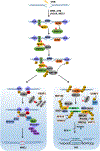Ubiquitylation in DNA double-strand break repair
- PMID: 33990032
- PMCID: PMC8207832
- DOI: 10.1016/j.dnarep.2021.103129
Ubiquitylation in DNA double-strand break repair
Abstract
Genome integrity is constantly challenged by various DNA lesions with DNA double-strand breaks (DSBs) as the most cytotoxic lesions. In order to faithfully repair DSBs, DNA damage response (DDR) signaling networks have evolved, which organize many multi-protein complexes to deal with the encountered DNA damage. Spatiotemporal dynamics of these protein complexes at DSBs are mainly modulated by post-translational modifications (PTMs). One of the most well-studied PTMs in DDR is ubiquitylation which can orchestrate cellular responses to DSBs, promote accurate DNA repair, and maintain genome integrity. Here, we summarize the recent advances of ubiquitin-dependent signaling in DDR and discuss how ubiquitylation crosstalks with other PTMs to control fundamental biological processes in DSB repair.
Keywords: DNA damage response; Double strand break; homologous recombination (HR); non-homologous end joining (NHEJ); ubiquitylation.
Copyright © 2021 Elsevier B.V. All rights reserved.
Conflict of interest statement
Conflict of interest
The authors declare no conflict of interest.
Figures



Similar articles
-
Analysis of chromatid-break-repair detects a homologous recombination to non-homologous end-joining switch with increasing load of DNA double-strand breaks.Mutat Res Genet Toxicol Environ Mutagen. 2021 Jul;867:503372. doi: 10.1016/j.mrgentox.2021.503372. Epub 2021 Jun 12. Mutat Res Genet Toxicol Environ Mutagen. 2021. PMID: 34266628
-
An E3 ubiquitin ligase localization screen uncovers DTX2 as a novel ADP-ribosylation-dependent regulator of DNA double-strand break repair.J Biol Chem. 2024 Aug;300(8):107545. doi: 10.1016/j.jbc.2024.107545. Epub 2024 Jul 9. J Biol Chem. 2024. PMID: 38992439 Free PMC article.
-
Balancing act: To be, or not to be ubiquitylated.Mutat Res. 2017 Oct;803-805:43-50. doi: 10.1016/j.mrfmmm.2017.07.006. Epub 2017 Jul 21. Mutat Res. 2017. PMID: 28764946 Review.
-
Regulation of Histone Ubiquitination in Response to DNA Double Strand Breaks.Cells. 2020 Jul 16;9(7):1699. doi: 10.3390/cells9071699. Cells. 2020. PMID: 32708614 Free PMC article. Review.
-
Homologous Recombination-Mediated DNA Repair and Implications for Clinical Treatment of Repair Defective Cancers.Methods Mol Biol. 2019;1999:3-29. doi: 10.1007/978-1-4939-9500-4_1. Methods Mol Biol. 2019. PMID: 31127567 Review.
Cited by
-
DNA Damage Response Regulation by Histone Ubiquitination.Int J Mol Sci. 2022 Jul 25;23(15):8187. doi: 10.3390/ijms23158187. Int J Mol Sci. 2022. PMID: 35897775 Free PMC article. Review.
-
Exploring the Structures and Functions of Macromolecular SLX4-Nuclease Complexes in Genome Stability.Front Genet. 2021 Nov 4;12:784167. doi: 10.3389/fgene.2021.784167. eCollection 2021. Front Genet. 2021. PMID: 34804132 Free PMC article. Review.
-
Latest Advancements of Natural Products in Combating Ovarian Cancer.J Cancer. 2025 Jul 28;16(11):3497-3512. doi: 10.7150/jca.118209. eCollection 2025. J Cancer. 2025. PMID: 40861811 Free PMC article. Review.
-
Crosstalk between ubiquitin ligases and ncRNAs drives cardiovascular disease progression.Front Immunol. 2024 Mar 7;15:1335519. doi: 10.3389/fimmu.2024.1335519. eCollection 2024. Front Immunol. 2024. PMID: 38515760 Free PMC article. Review.
-
VGLL3 modulates chemosensitivity through promoting DNA double-strand break repair.Sci Adv. 2024 Oct 11;10(41):eadr2643. doi: 10.1126/sciadv.adr2643. Epub 2024 Oct 9. Sci Adv. 2024. PMID: 39383226 Free PMC article.
References
-
- Harper JW, Elledge SJ, The DNA damage response: ten years after, Mol Cell, 28 (2007) 739–745. - PubMed
Publication types
MeSH terms
Substances
Grants and funding
LinkOut - more resources
Full Text Sources
Other Literature Sources
Miscellaneous

